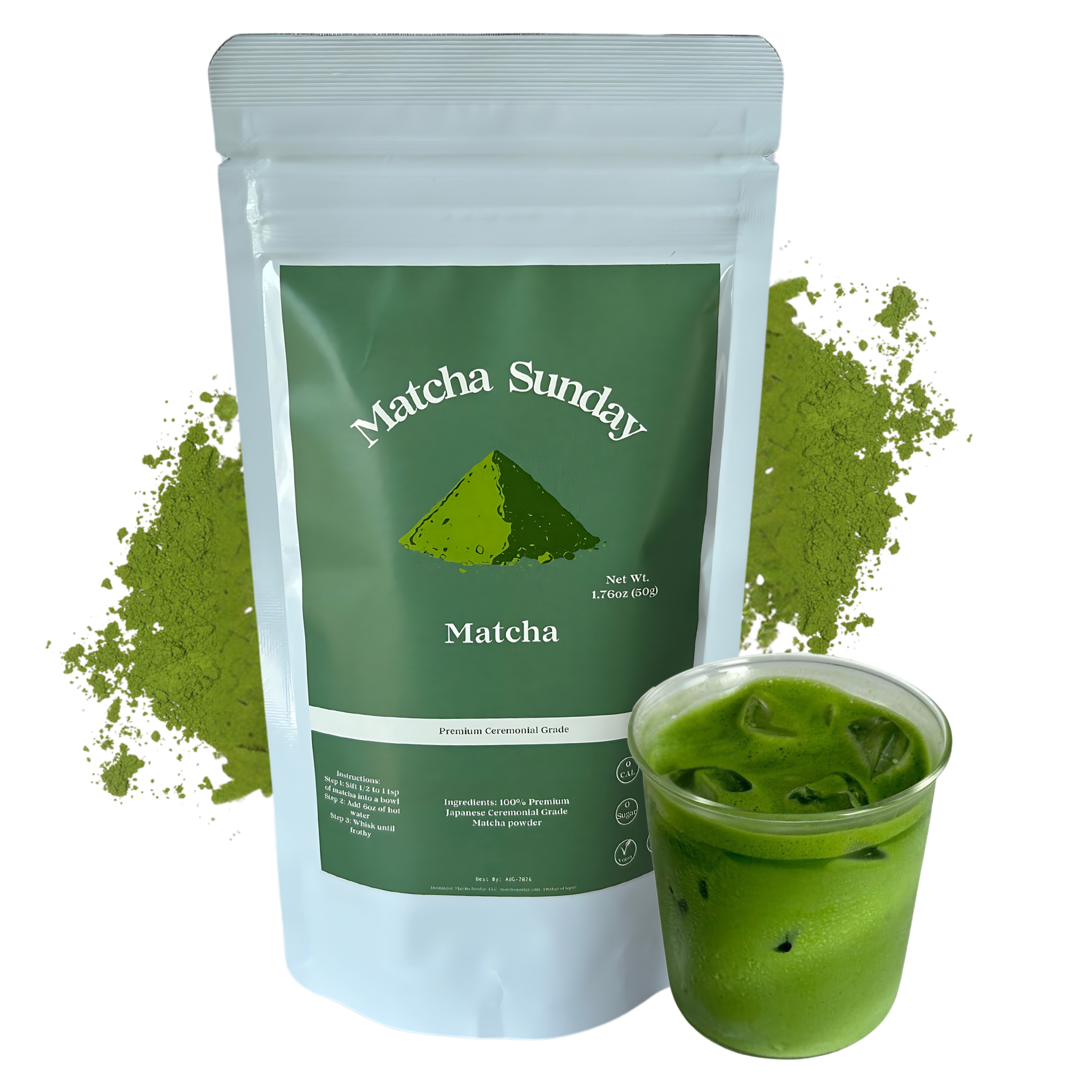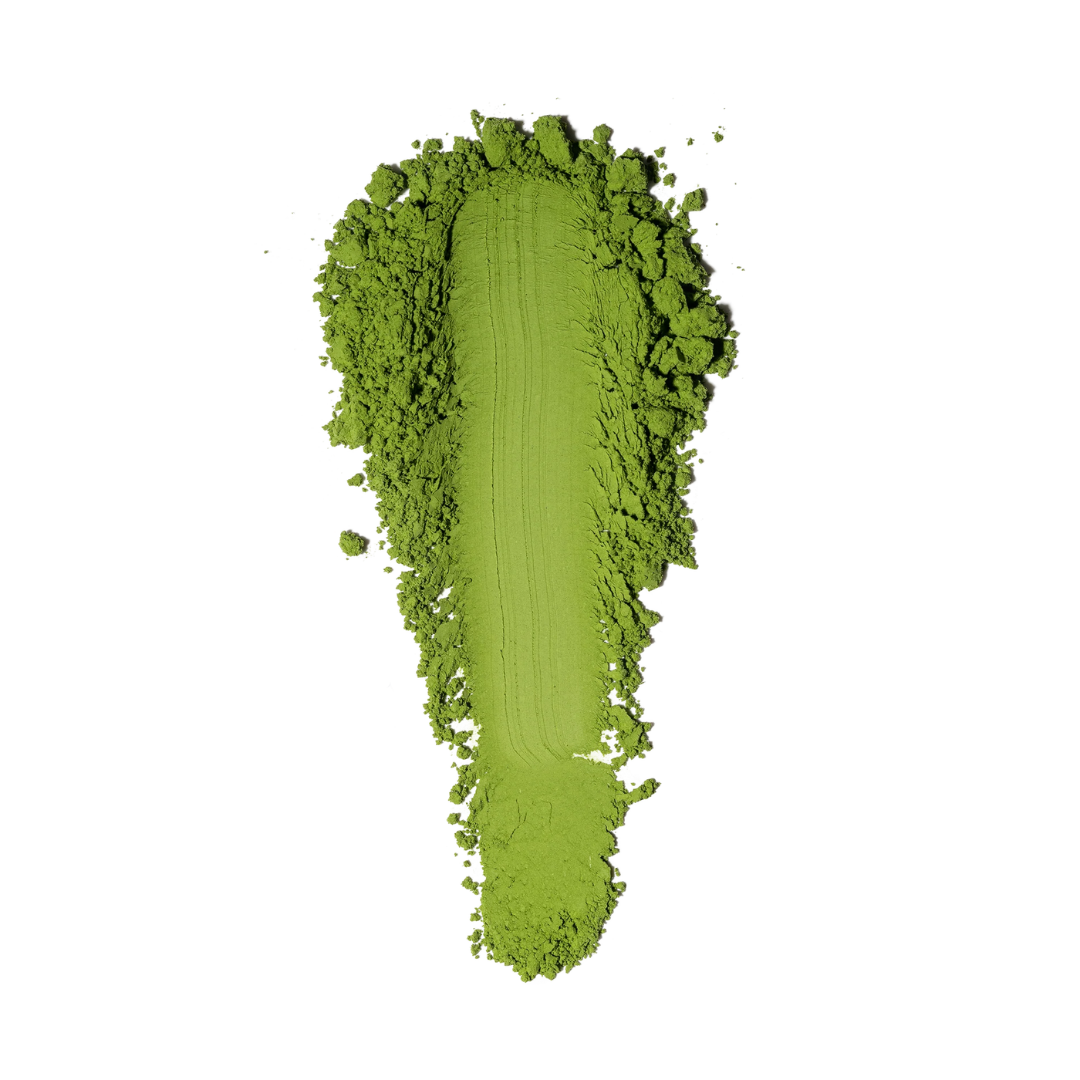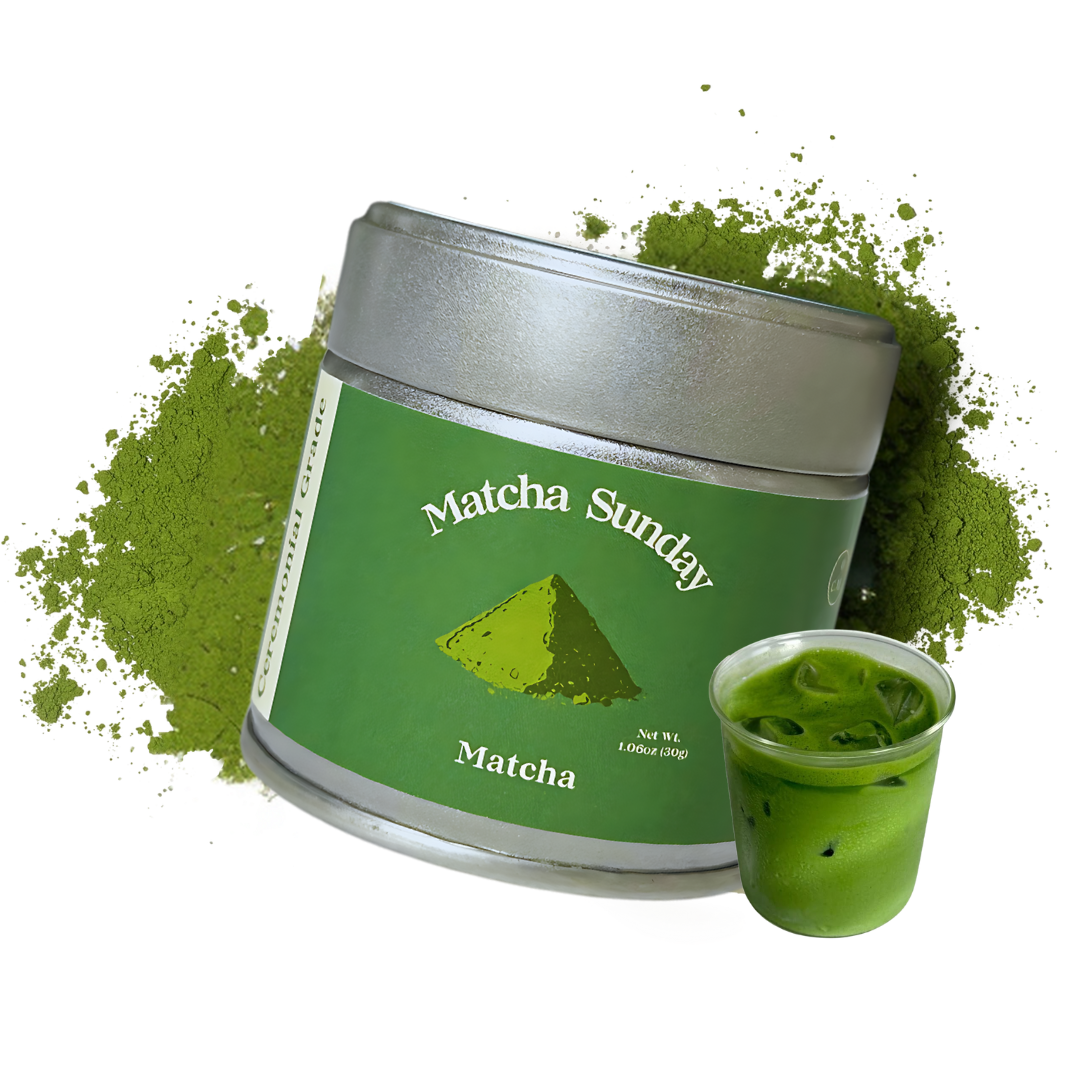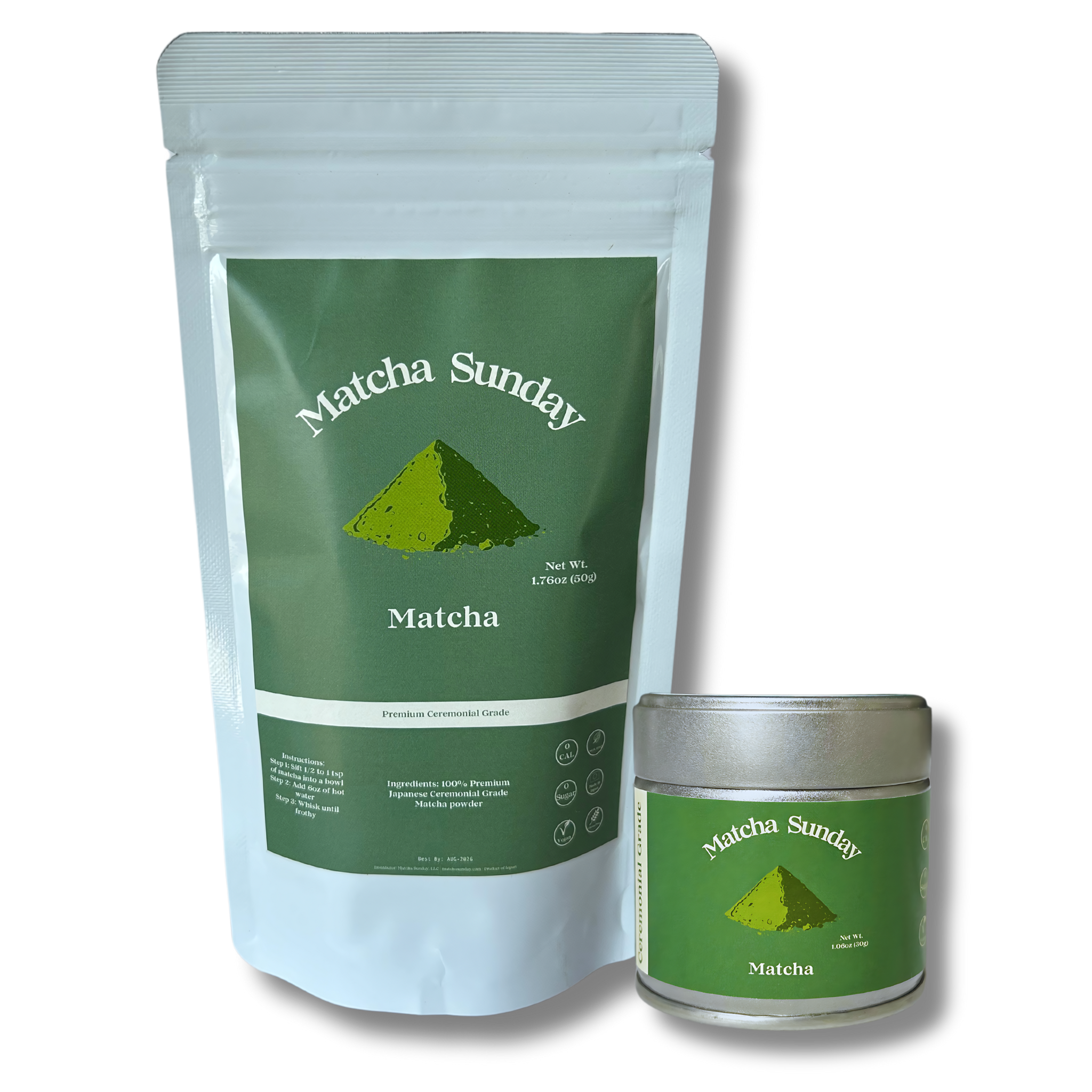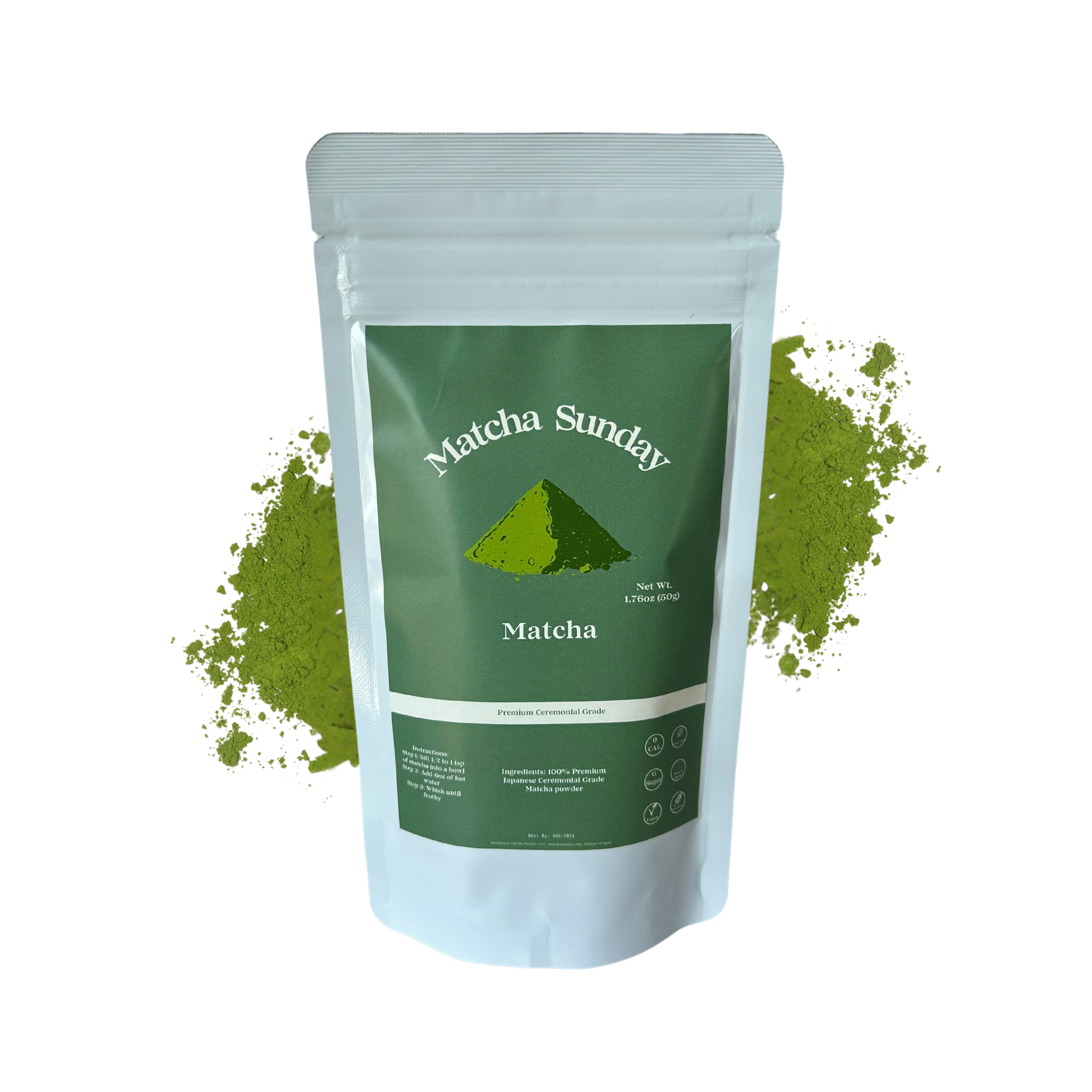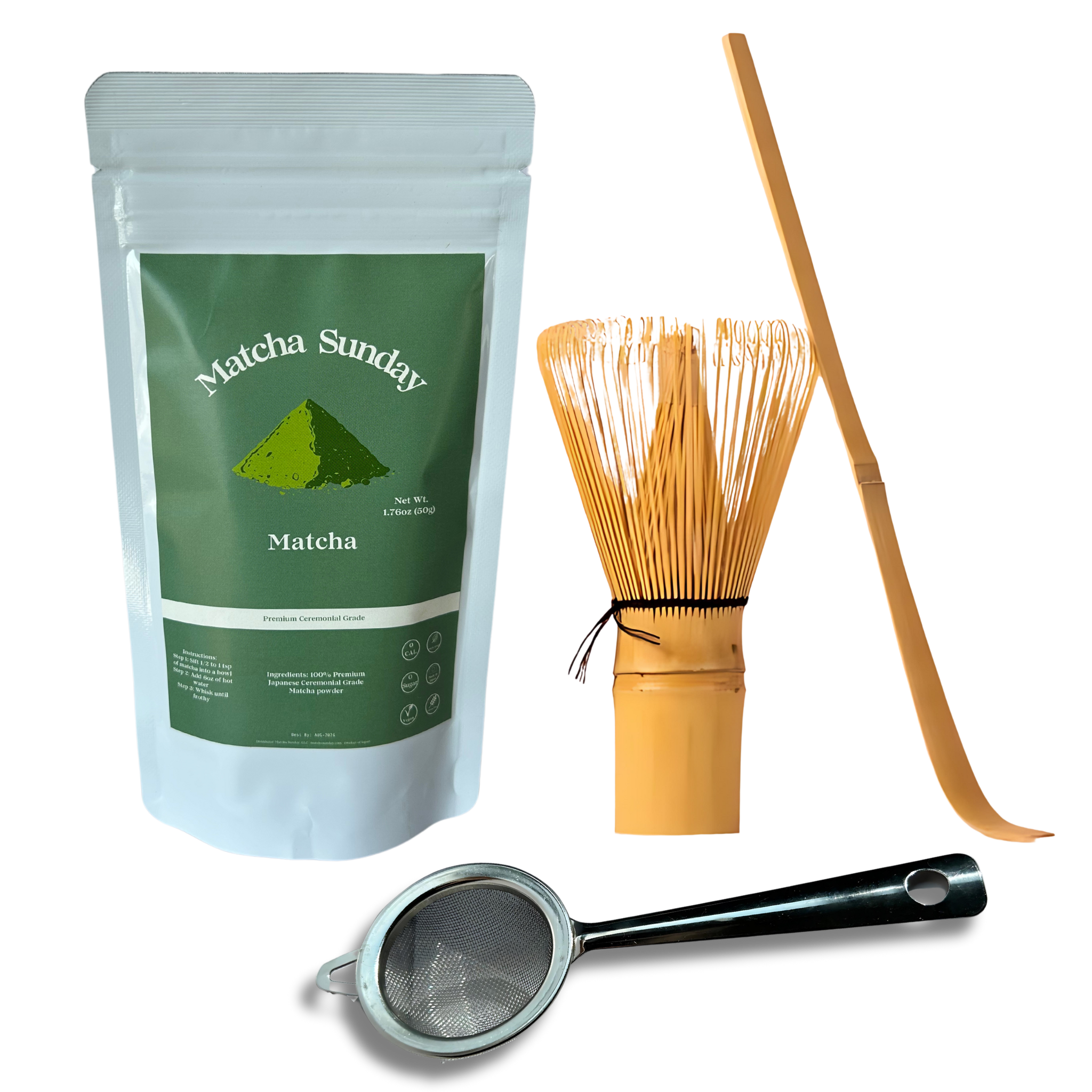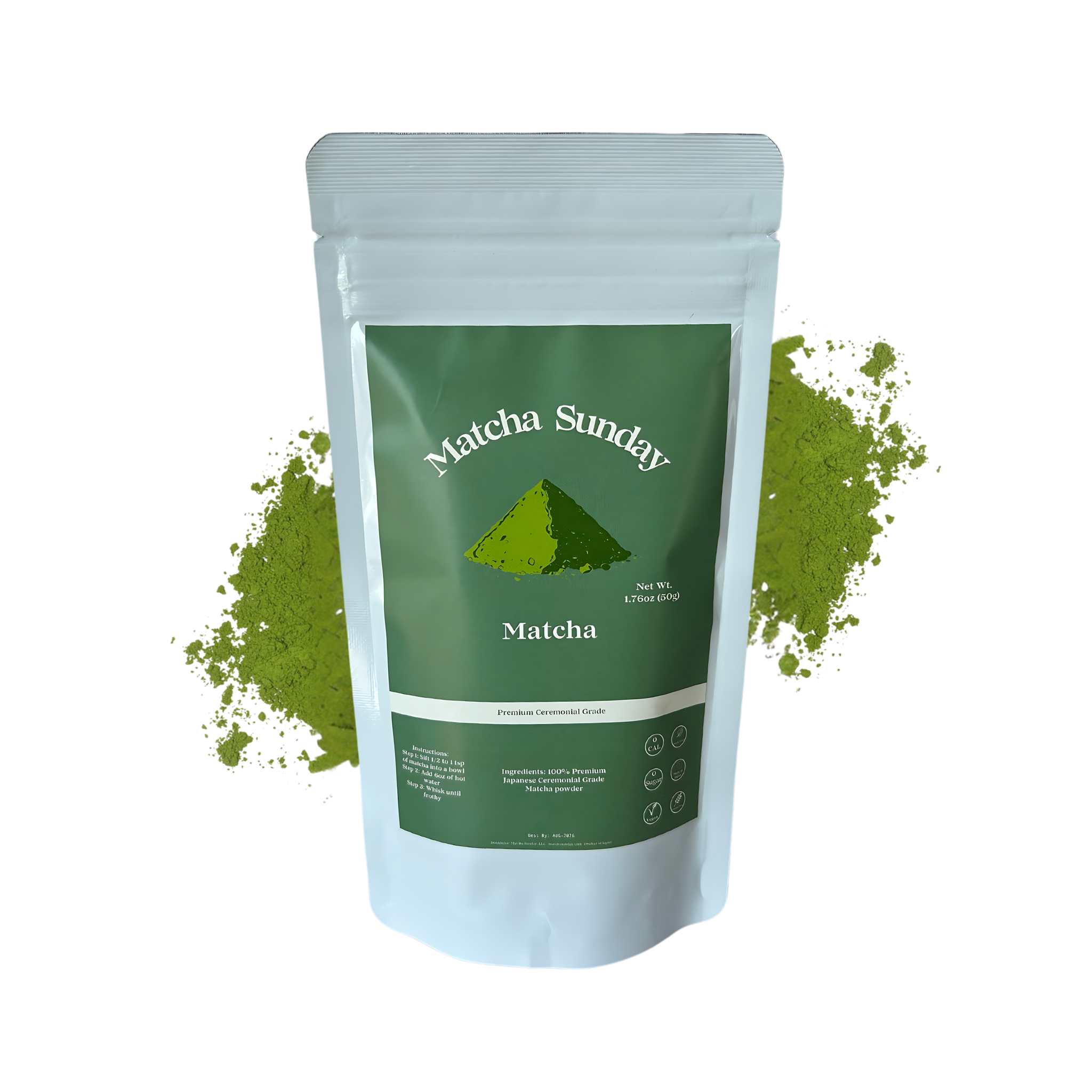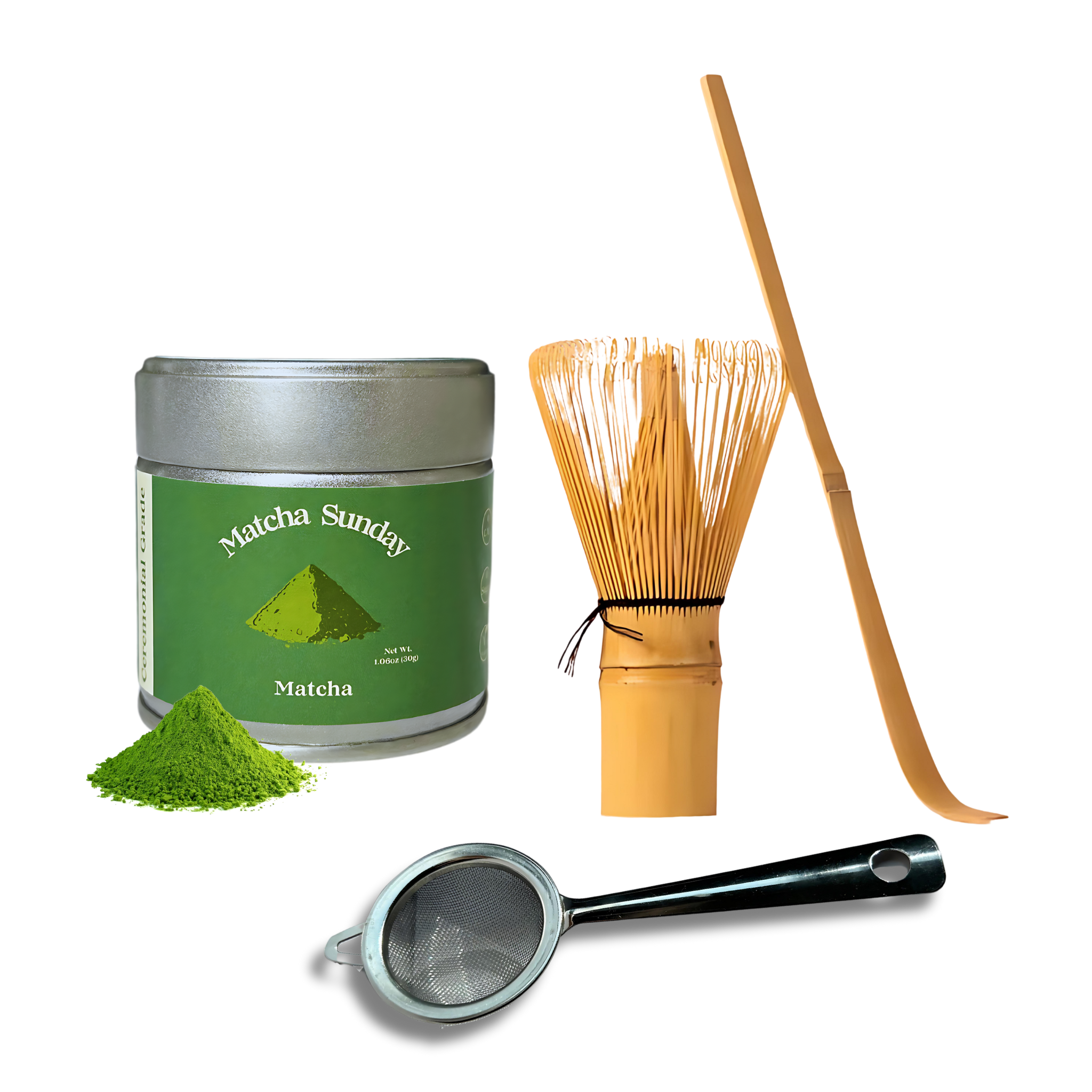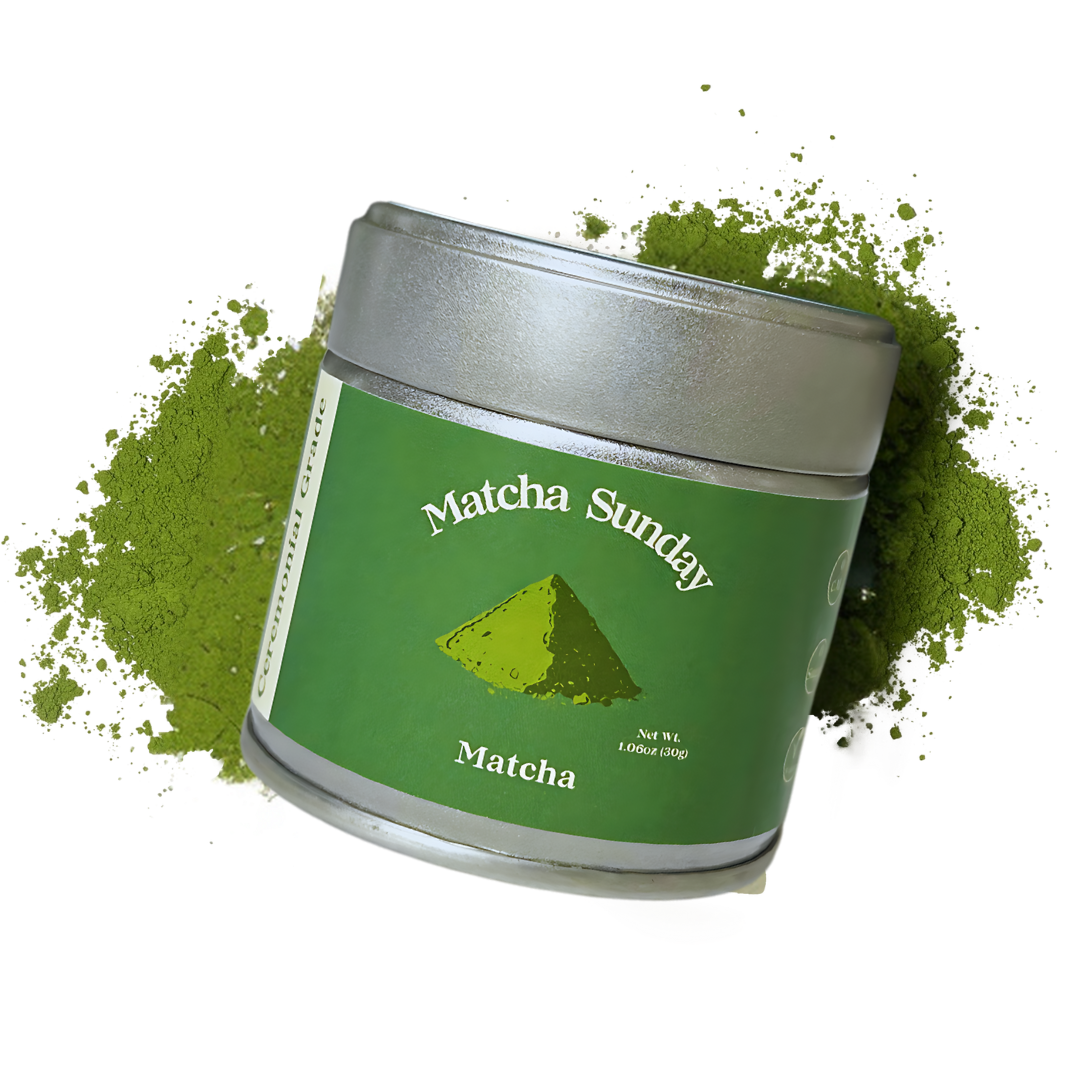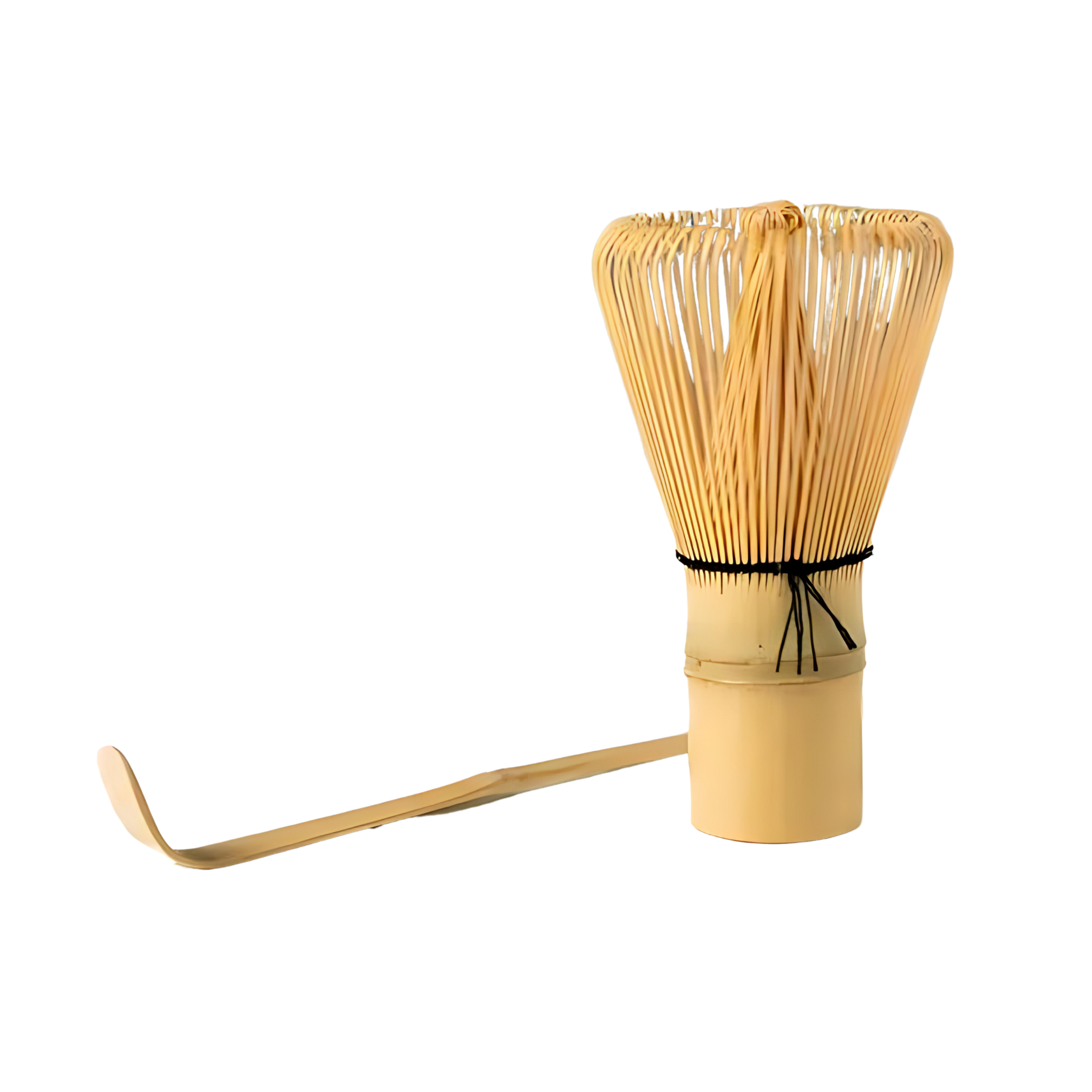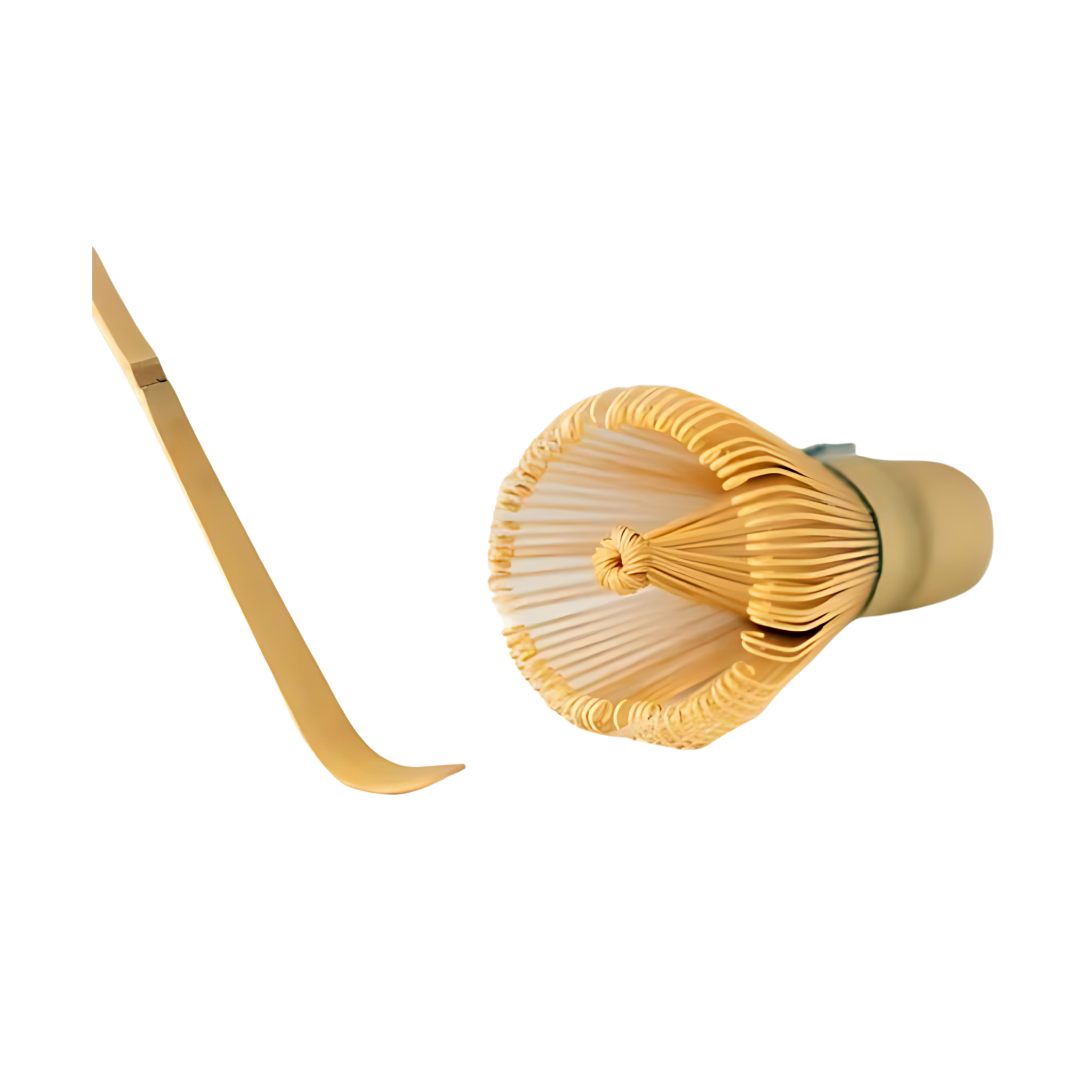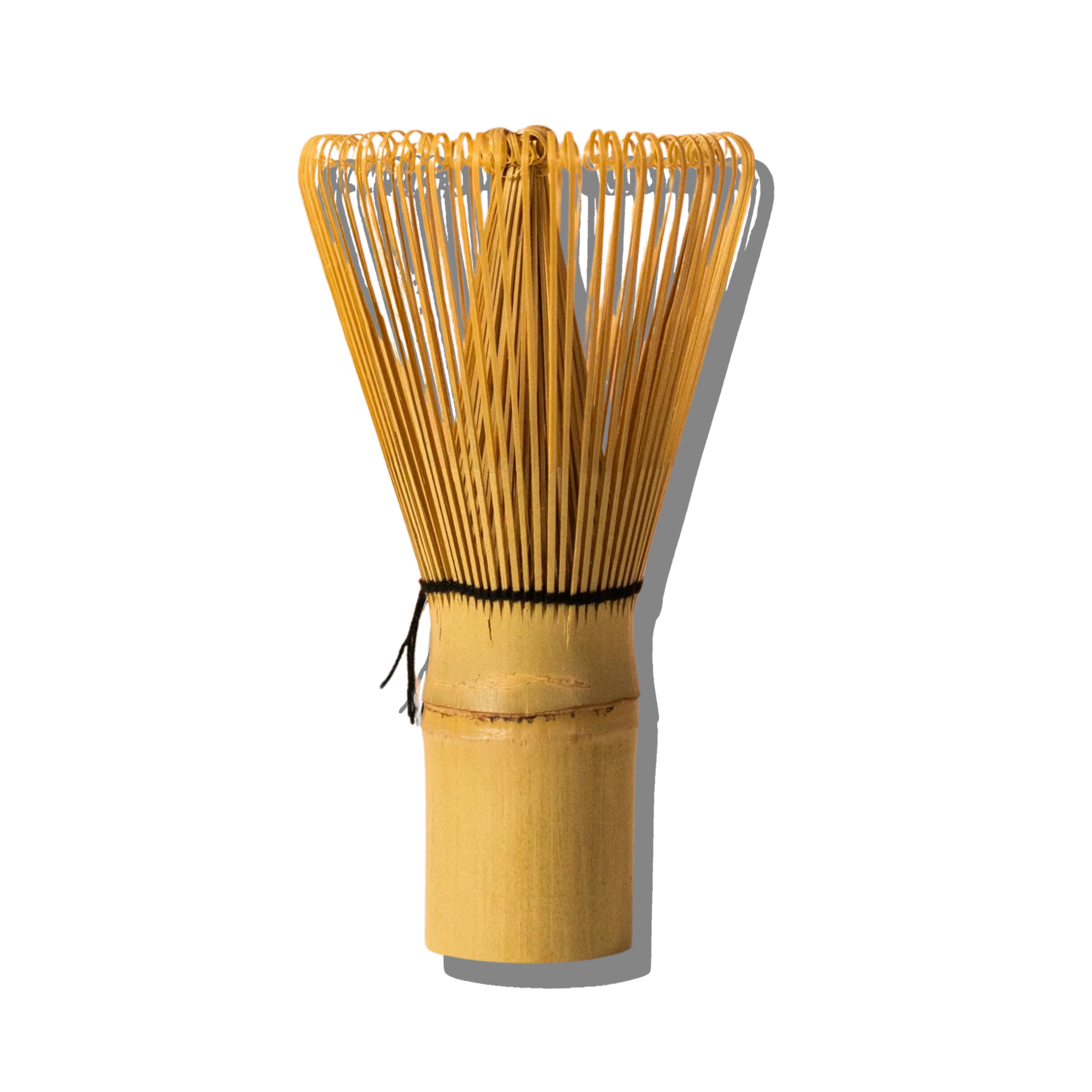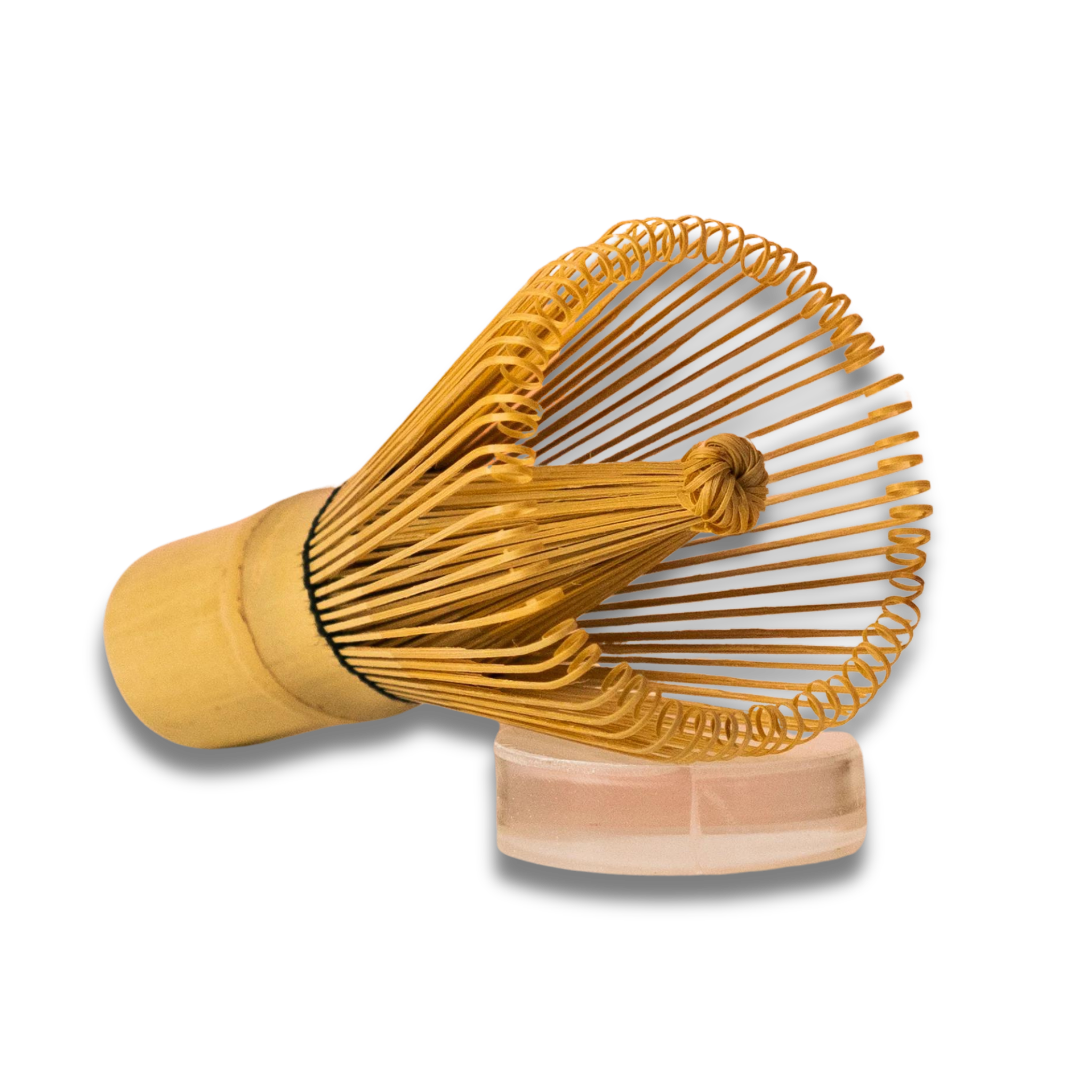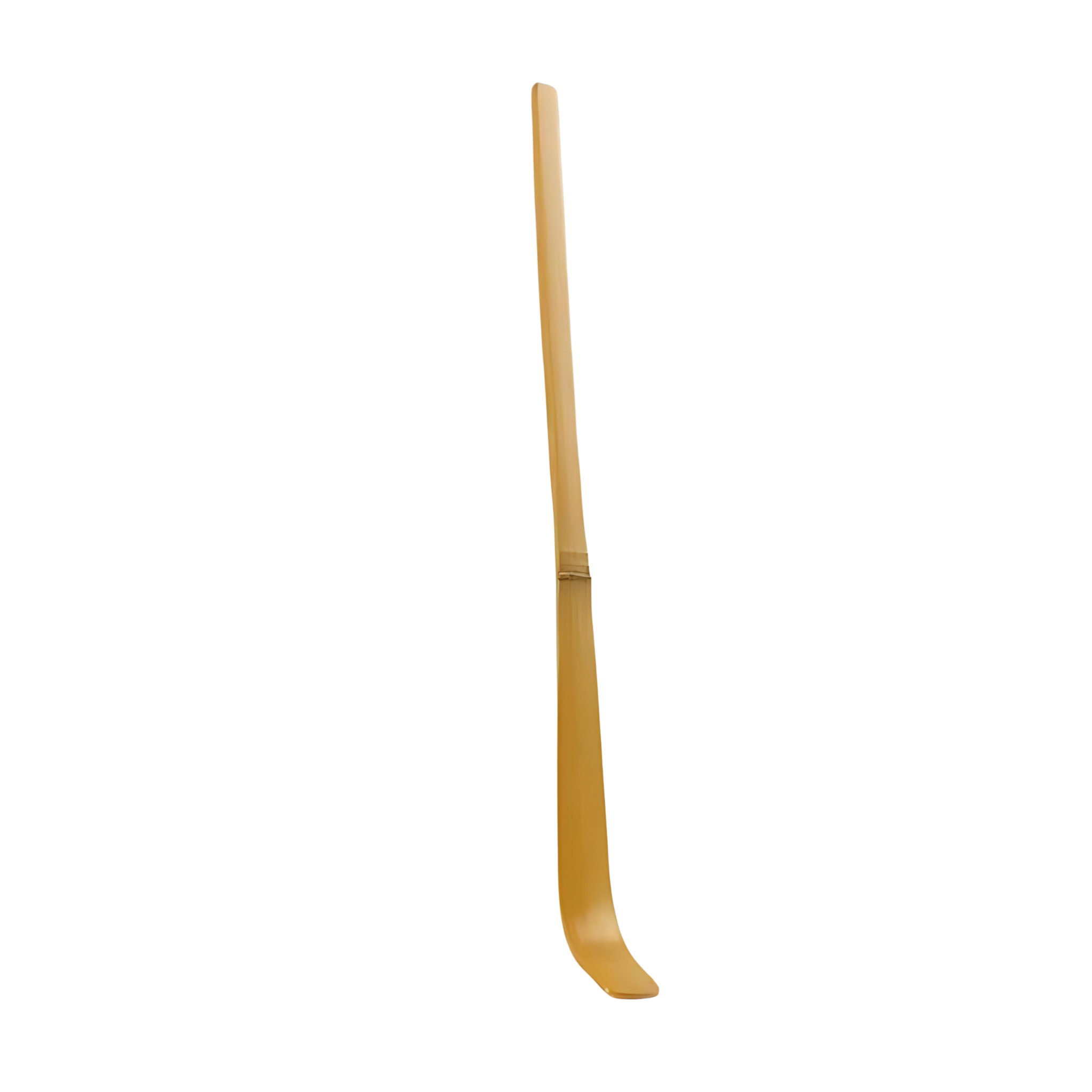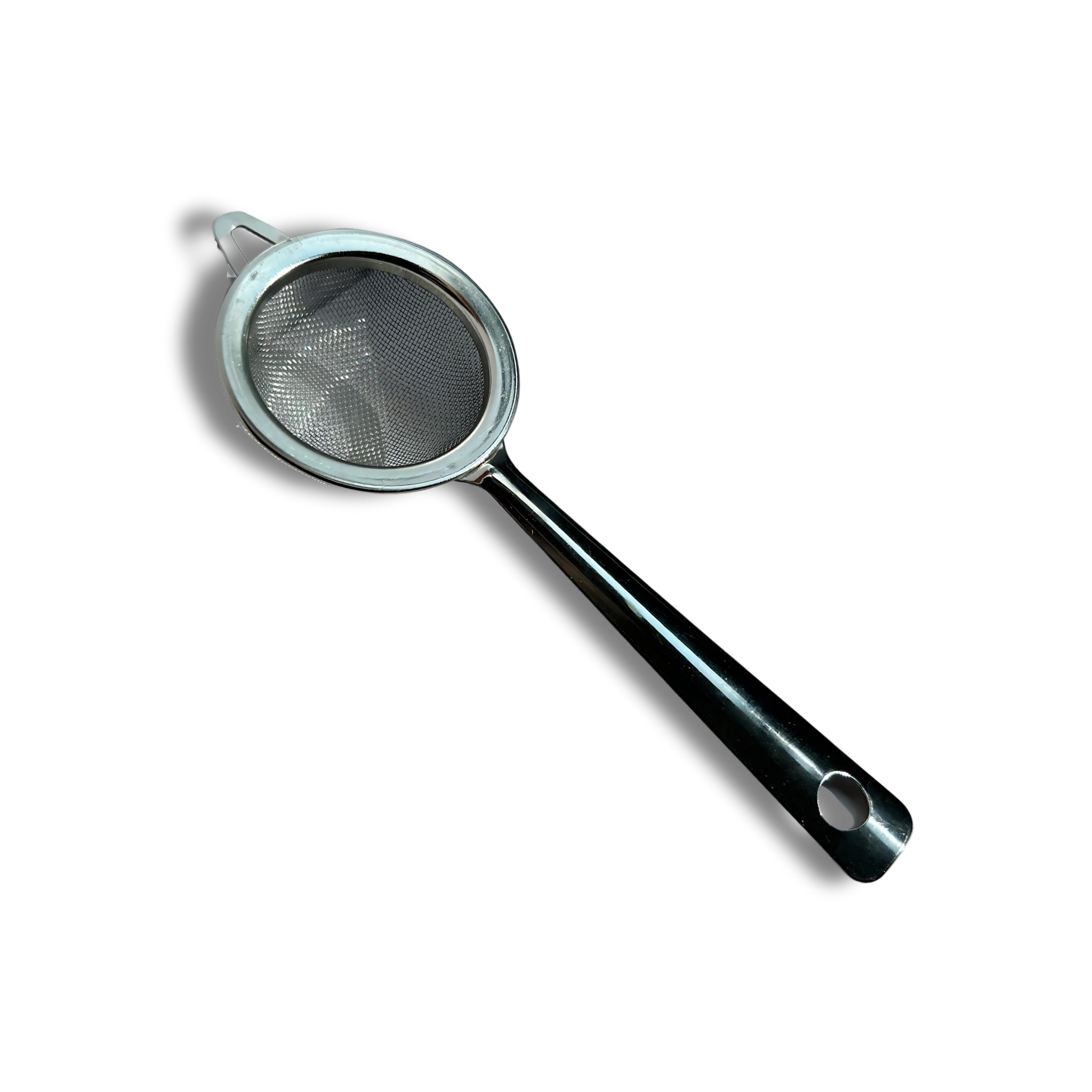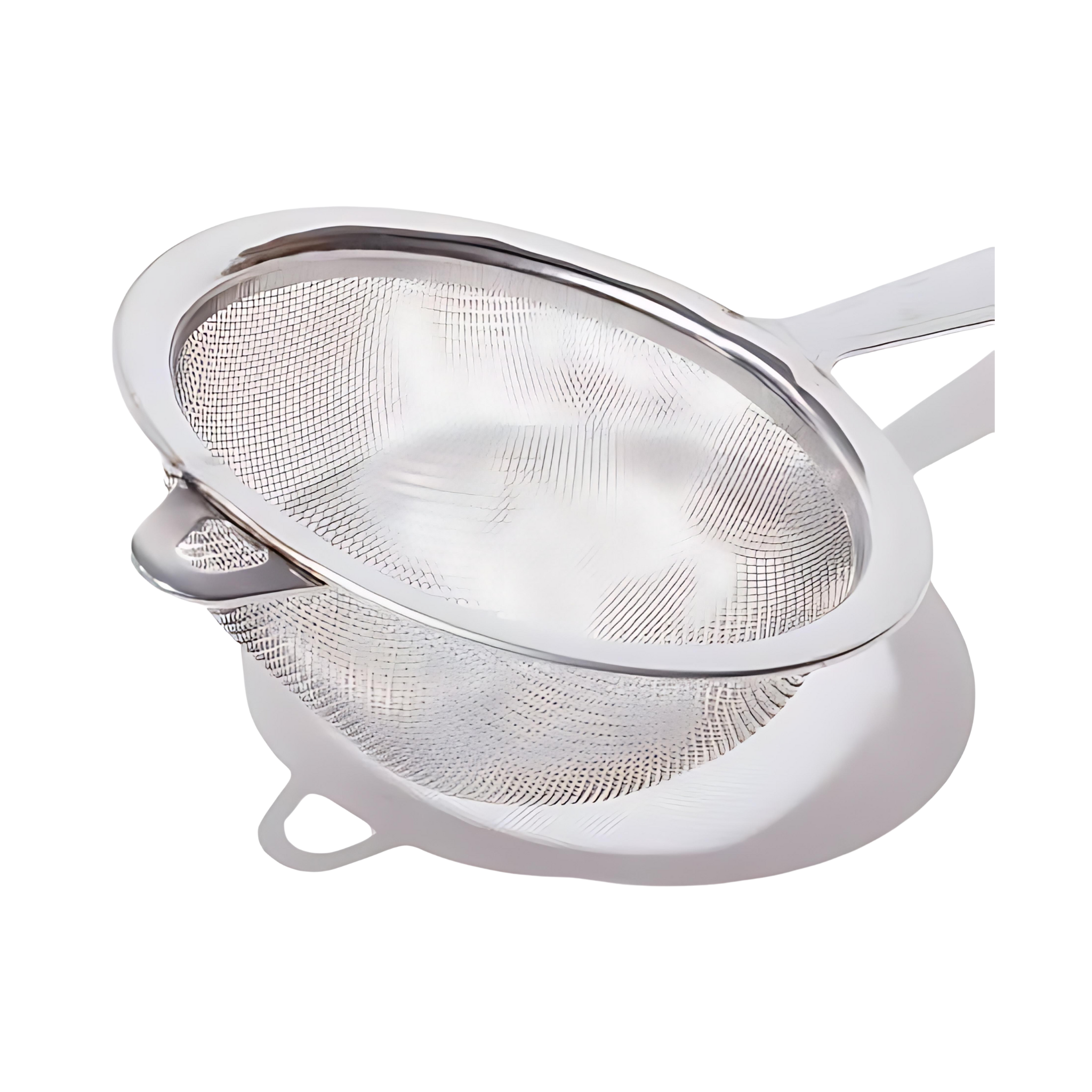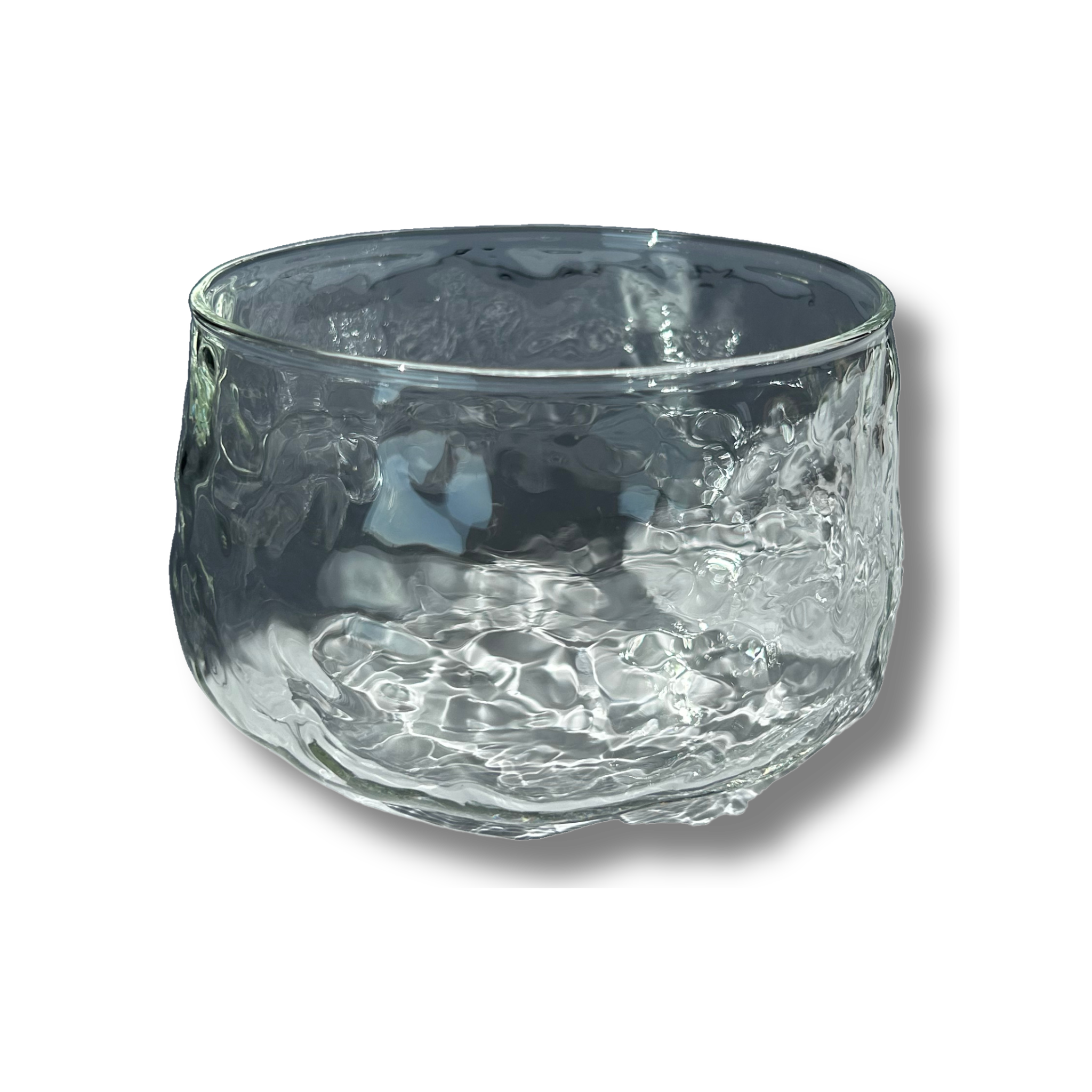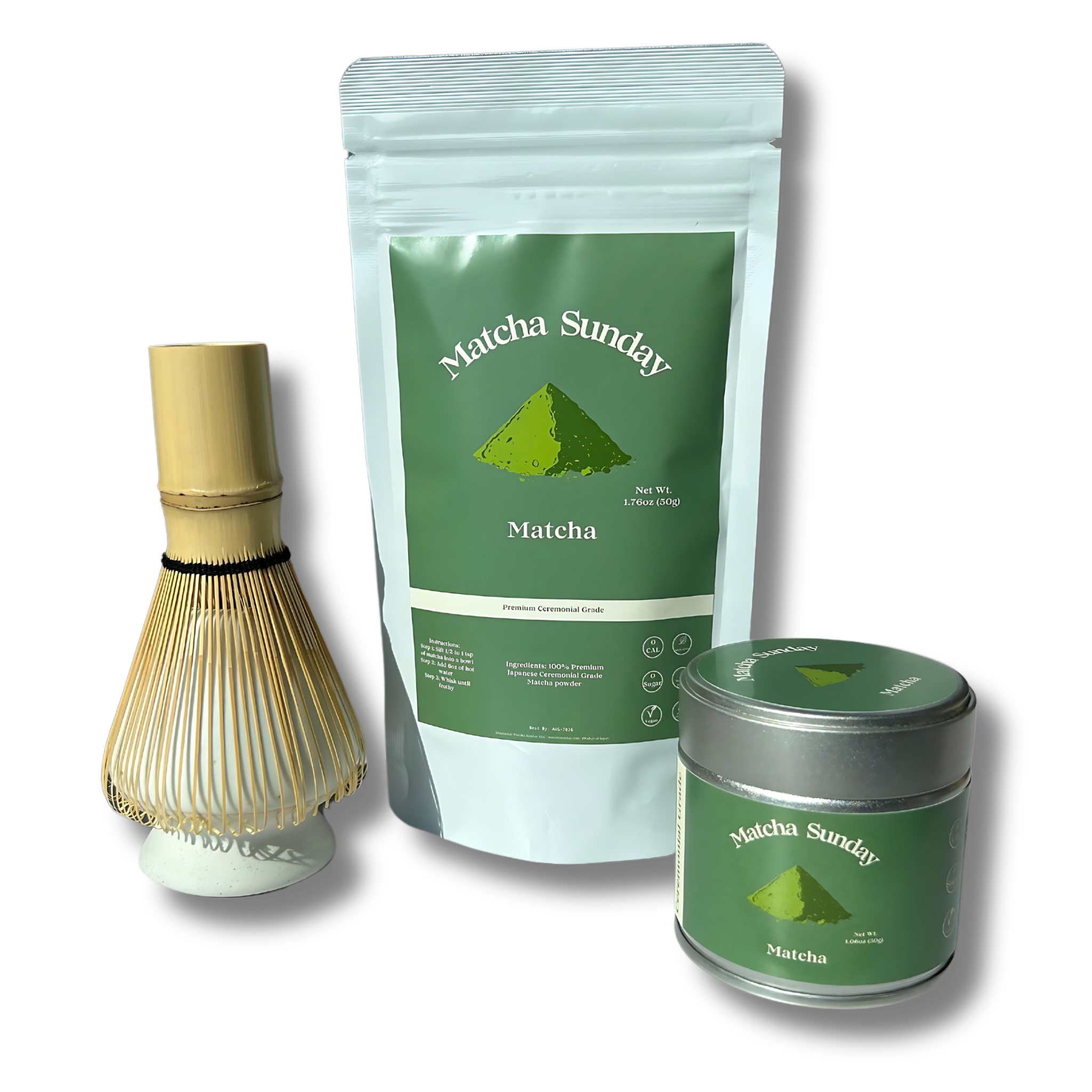A perfect matcha latte feels like a small ceremony. Calm in a cup. Color that wakes the senses before the first sip. When your ratios are right, the flavor turns focused, creamy, and clear.
Ratios matter because matcha is concentrated. A gram too much and bitterness blooms. A splash too little milk and the body thins. Precision invites the flavor to bloom without noise.
Why This Guide Matters
Ratios are the difference between a bitter sip and a layered experience. They shape mouthfeel, sweetness, and energy. When you dial them in, your morning ritual becomes effortless and repeatable.
The Big Picture
Think in parts. Matcha is your base, water is your bloom, and milk is your body. Adjust one, and the others respond. The goal is harmony, not dominance.
The Science Behind It
Matcha is ground leaf, not extracted coffee. You drink the whole leaf. So concentration shows fast. Proteins in milk soften tannins. Fats carry aroma. Temperature affects sweetness perception and foam.
Studies suggest L-theanine in matcha smooths caffeine’s rise. That’s why the energy feels steady, not spiky. Flavor follows chemistry. Texture follows technique.

What You Need To Begin
You don’t need a café bar to make café-level lattes. A few tools change everything. The right grade of matcha, the right whisk, and good water create a balanced base.
Essential Tools And Ingredients
Start with ceremonial grade matcha for lattes where flavor leads. Culinary grade can work in baking, smoothies, or sweet-forward drinks. Water should be filtered and soft to medium mineral. Milk should match your texture goals.
- Ceremonial Grade Matcha (bright, sweet, vibrant)
- Bamboo Whisk (chasen) or a handheld frother
- Fine Sieve for clump-free powder
- Scale or Measuring Spoon for precision
- Kettle with Temperature Control
- Milk Frother or Steam Wand
- Fresh Milk or Barista-Style Plant Milk
Why Tools Matter
Matcha clumps easily. A sieve and whisk turn powder into velvet. Temperature control prevents bitterness. A good milk frother builds microfoam for a satin finish.
Mini-Fact: A gram scale adds more consistency than any single upgrade. Once you feel your base, you can riff with confidence.
Hot Matcha Latte: The Core Ratios
A hot latte is about warmth and roundness. The water bloom unlocks aroma. Milk wraps it in texture. Start with a base ratio, then adjust by taste.
Classic Ratio (12 oz cup)
Use 2 grams of matcha, 2 ounces of hot water, and 8 ounces of milk. This balance highlights sweetness and depth. It avoids bitterness while leaving room for nuance.
Stronger, Café-Style
For a bolder profile, use 2.5 to 3 grams of matcha. Keep water at 2 ounces. Maintain milk between 6 and 8 ounces. Expect a denser green, more cocoa-like depth, and a longer finish.
Lighter, Tea-Forward
Use 1.5 grams of matcha, 2 ounces of water, and 8 to 10 ounces of milk. The texture stays silky. The flavor leans springy, floral, and gentle.
Step-By-Step: Hot Matcha Latte
1. Preheat your bowl and cup with hot water. Empty them.
2. Sift 2 grams of matcha into the bowl to break clumps.
3. Heat water to 160–175°F (71–79°C). Avoid boiling.
4. Add 2 ounces of hot water to the matcha. Whisk in a fast W motion until frothy.
5. Heat or steam 6–10 ounces of milk to 140–150°F (60–65°C). Aim for microfoam.
6. Pour milk into the whisked matcha. Swirl to integrate and taste.
7. Adjust sweetness or milk level. Serve immediately.
Why This Works
Blooming the matcha in water unlocks aroma compounds. Milk added afterward preserves foam and clarity. Lower water temperature protects sweetness. Moderate milk temperature keeps proteins flexible and silky.
Common Mistakes To Avoid
- Using boiling water, which can flatten sweetness and spike bitterness
- Skipping the sift, leading to chalky clumps that won’t dissolve
- Overheating milk beyond 155°F, which breaks proteins and dulls mouthfeel
- Under-whisking, causing separation and thin texture
Quick Tips
- Switch to a larger cup for stronger ratios; avoid overflow during pouring.
- Try 50/50 dairy and oat milk for balance: body plus sweetness.
- If you like less foam, tap the pitcher and swirl to settle microbubbles.
Iced Matcha Latte: Cold, Crisp, And Balanced
Cold brings clarity. Iced lattes need more matcha to stand up to dilution. Ice chills aroma perception, so raise the green to keep the flavor bright.
Core Iced Ratio (16 oz glass)
Use 2.5 to 3 grams of matcha, 2 ounces of cool or warm water, 8 to 10 ounces of cold milk, and a full glass of ice. The result is crisp, creamy, and tuned for warm days.
Stronger Iced, Café-Special
Push matcha to 3.5 grams if you love deep green flavor. Keep water at 2 ounces. Milk at 8 to 9 ounces. Fill with ice last to protect texture.
Step-By-Step: Iced Matcha Latte
1. Sift 2.5–3 grams of matcha into a shaker or bowl.
2. Add 2 ounces of cool water (or warm at 120°F for easier dissolution).
3. Whisk or shake vigorously for 15–20 seconds until glossy and smooth.
4. Fill a tall glass with ice. Pour 8–10 ounces of cold milk over the ice.
5. Add your matcha concentrate. Stir gently to marble the green.
6. Sweeten to taste with simple syrup, maple, or honey. Sip immediately.

Why Cold Needs More Matcha
Chill mutes sweetness and aroma. Higher matcha ratios restore balance. Ice adds dilution over time. A concentrated base keeps flavor steady to the last sip.
Common Iced Pitfalls
- Adding matcha powder directly to milk, which clumps instantly
- Using crushed ice, which melts too fast and thins the drink
- Under-dosing matcha, leaving a pale, watery finish
- Over-sweetening, which masks green depth
The Milk Matrix: Choose Your Texture
Milk isn’t just a vehicle. It’s a texture architect. Protein and fat matter. The right choice shapes foam, weight, and flavor clarity.
Dairy Options
- Whole Milk: richest body, stable microfoam, warmer finish
- 2% Milk: lighter, still silky, slightly brighter flavor
- Skim Milk: high foam volume, leaner texture, sharper profile
Plant Milks, Compared
- Oat: naturally sweet, neutral grain note, easy latte art
- Almond: light body, toasty aroma, lower foam stability
- Soy: solid foam, subtle bean note, balanced body
- Coconut: creamy, tropical aroma, can dominate delicate matcha
- Barista-Style Blends: optimized proteins and oils for foam and pour
Why This Matters
Milk proteins bind with astringent compounds, rounding edges. Fat carries aroma and builds mouthfeel. Choose milk based on the experience you want, not just habit.
Foam And Temperature Targets
- Hot Lattes: 140–150°F (60–65°C) for silk and sweetness
- Extra Foam: 150–155°F for more lift without scalding
- Iced Lattes: Froth cold milk, or steam lightly then chill over ice
The Science Bit
Studies suggest sweetness perception peaks around 140–149°F in milk drinks. Above 155°F, milk can taste flat. Keep your thermometer nearby. Your tongue will notice.
Sweetness And Flavor Pairings
Matcha’s flavor is layered: green, creamy, sometimes floral or cocoa-like. Sweetness should highlight, not hide. Think light and clean. Avoid heavy syrups unless you want dessert.
Smart Sweeteners
- Maple Syrup: warm, soft sweetness that complements cacao notes
- Honey: floral lift, particularly in spring harvest matcha
- Simple Syrup: clean and consistent, ideal for iced lattes
- Date Syrup: caramel depth, use lightly to avoid takeover
- Coconut Sugar: toasty, pairs well with almond milk
Flavor Twists That Work
- Vanilla bean or paste for roundness
- Cardamom for aromatic lift
- A pinch of sea salt to sharpen sweetness
- Fresh yuzu or lemon zest for brightness in iced versions
Why Flavor Matters
Matcha shifts with harvest and grade. Spring lots lean sweet and floral. Summer can be deeper and more savory. Your add-ins should mirror the leaf’s mood.
Caffeine, L-Theanine, And Focus
Matcha offers alertness with a softer edge. You drink the whole leaf, so the effect is steady. Depending on grade, one gram can contain roughly 25–35 mg of caffeine. A typical latte uses 2–3 grams.
Studies suggest L-theanine may support calm, sustained attention. Many people feel “clear energy” without jitters. The ratio you choose affects intensity. More matcha, more lift. Less matcha, more ease.
Why This Helps Your Day
A well-proportioned latte can replace an afternoon coffee. It steadies the curve. Pair with a short walk and sunlight for the full effect. Hydration also matters.
Tuning Ratios To Your Goals
Your latte can be a gentle companion or a focused tool. Decide what you want before you whisk. Then set your scale.
For Morning Focus
Use 2.5–3 grams matcha, moderate milk, and minimal sweetness. Keep water at 2 ounces. Aim for a clean, bright finish. Sip slowly.
For Afternoon Ease
Use 1.5–2 grams matcha, a bit more milk, and subtle honey. Keep it warm, not hot. Feel the shoulders drop.
For Pre-Workout Clarity
Use 3–3.5 grams matcha in an iced base. Little to no sweetener. Oat or soy milk for body. Hydrate alongside.
Designing Your Ritual
Ritual builds consistency. Consistency builds results. Set your space like a studio. Keep tools tidy. Choose a cup you love.
Setup That Inspires
- A dedicated tray with your whisk, scoop, and sieve
- A small canister for matcha within easy reach
- A favorite bowl or pitcher for whisking
- A scale that turns on with one touch
Why It Matters
When your tools are ready, friction fades. You make better drinks more often. Your latte becomes a daily meditation in motion.
Water Quality, Quietly Crucial
Great water lifts matcha. Hard water dulls nuance. Soft to medium mineral content offers clarity. Filtered water tastes cleaner and lets sweetness shine.
Quick Water Tips
- Use filtered water with 50–150 ppm total dissolved solids
- Avoid distilled water, which can taste flat and harsh
- If your water is hard, consider a countertop filter
Storage And Freshness
Matcha is delicate. Light, heat, and air steal its magic. Protect the green. You’ll taste the difference in every sip.
How To Store Matcha
1. Keep it in an opaque, airtight tin.
2. Store in a cool, dark place away from heat sources.
3. Reseal quickly after scooping to limit oxygen.
4. For long gaps between use, refrigerate in a sealed container.
5. Consume within 60–90 days of opening for peak flavor.

Why Storage Changes Flavor
Chlorophyll breaks down with light and heat. Aroma fades with oxygen. Fresh matcha smells like spring grass and cocoa. Stale matcha smells dull and dusty.
Upgrading Grade And Harvest
Ceremonial grade offers sweetness and a soft finish. Culinary grade is perfect for smoothies or recipes. If you love iced lattes, consider a slightly higher dose of ceremonial. The clarity holds, even through ice.
Temperature And Technique, Side By Side
The best ratio fails if technique falters. Keep the motion light and quick. Think air and gloss. You want tiny bubbles, not big ones.
Whisking Notes
- Use a zigzag W motion, not circular stirring
- Keep the whisk near the bowl’s bottom, not scraping hard
- Stop when the surface turns glossy with a fine foam
Frothing, Refined
- Purge steam wands before and after use
- Angle the pitcher for a gentle whirlpool
- Listen for a soft, satin hiss, not loud bubbles
Troubleshooting: Quick Fixes
Every cup teaches you something. Adjust one variable at a time. Keep notes. Your ideal recipe will emerge.
If It’s Bitter
- Lower water temperature by 5–10°F
- Use slightly less matcha or more milk
- Switch to a fresher, higher grade
If It’s Too Thin
- Add 0.5 grams more matcha
- Reduce milk by 1–2 ounces
- Improve frothing to boost body
If It’s Chalky
- Sift the powder more carefully
- Whisk longer or use warmer water for the bloom
- Check your matcha freshness
If It Separates
- Whisk more vigorously to create emulsion
- Use barista-style plant milk for stability
- Serve immediately and swirl before each sip
Ratios For Different Cup Sizes
Keep the same proportions as you scale up or down. Think in grams, not teaspoons, for reliable results. Your scale keeps you honest.
8 oz Hot Latte
- 1.5–2 grams matcha
- 1.5–2 ounces water
- 5–6 ounces milk
12 oz Hot Latte
- 2–2.5 grams matcha
- 2 ounces water
- 7–9 ounces milk
16 oz Iced Latte
- 2.5–3.5 grams matcha
- 2 ounces water
- 8–10 ounces milk + ice
Seasonal Adjustments
Your tongue craves different textures as weather shifts. Let the seasons guide your ratios.
Spring
- Lighter matcha dose, floral sweeteners like honey
- More foam for a cushiony feel
Summer
- Higher matcha dose for iced clarity
- Less sweetness, more citrus zest
Autumn
- Slightly richer milk, maple syrup
- A pinch of cinnamon or cardamom
Winter
- Hotter cup, within safe ranges
- Heavier microfoam and a dash of vanilla
Sustainability, Subtle And Real
Choose organic matcha when possible. It supports careful farming and soil health. Buy smaller tins to reduce waste from staling. Use tools that last, like a bamboo whisk you care for.
Care For Your Tools
- Rinse whisk with warm water only, no soap
- Dry bristles upward on a stand
- Replace when tines split or shed
Why Care Extends Flavor
Clean tools keep flavors pure. Old milk residues muddy your latte’s finish. A cared-for chasen creates smoother foam and fewer clumps. It’s a small detail with big impact.
A Mini Tasting Ritual
Taste your matcha plain before building the latte. A sip tells you the day’s color. Sweet, grassy, or deep. Now choose milk, ratio, and sweetener to match what you taste.
How To Tasting-Check
1. Whisk 1 gram matcha with 2 ounces warm water.
2. Sip gently, noting sweetness, bitterness, and finish.
3. Choose lighter or stronger latte ratios accordingly.
Key Takeaways
- Ratios guide flavor, texture, and energy; measure in grams for consistency
- Hot lattes thrive at 2 g matcha, 2 oz water, and 6–10 oz milk
- Iced lattes need 2.5–3.5 g matcha to stay bright over ice
- Keep water 160–175°F to protect sweetness and avoid bitterness
- Sift, whisk, and froth for silk; technique shapes mouthfeel
- Choose milk for texture goals; barista-style plant milks add stability
- Store matcha airtight, cool, and dark; use within 60–90 days
- Adjust with the seasons and your goals: focus, ease, or clarity
If you’re ready to refine your ritual, start with a fresh tin of Matcha Sunday Ceremonial Grade Matcha and a bamboo whisk. These two simple upgrades bring café-level lattes home, hot or iced, every time.



